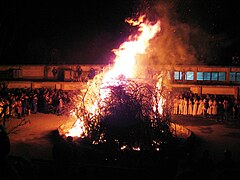Sadeh
| Sadeh جشن سده |
|
|---|---|

Sadeh in Tehranpars Markar, 2011
|
|
| Also called | Jashn-e Sadeh (Persian: جشن سده) |
| Observed by |
|
| Date | January 28, 29 |
| 2017 date | 29 January |
| Frequency | annual |
| Related to | Nowruz, Tirgan, Mehregan, Yalda |
Sadeh (Persian: سده also transliterated as Sade), is an ancient Iranian festival that dates back to the first Persian Empire, Achaemenid Empire.Sadeh celebrates 50 days before Nowruz. Sadeh in Persian means "hundred" and refers to one hundred days and nights past the end of summer (or the beginning of long-winter known to start at the end of summer in ancient Iran). Sadeh is a mid winter festival that was celebrated with grandeur and magnificence in ancient Persia. It was a festivity to honor fire and to defeat the forces of darkness, frost, and cold.
Legends have it that King Hushang, the 2nd king of the mythological Pishdadian dynasty (Pishdad means to give the Law), established the Sadeh tradition. It is said that once Hushang was climbing a mountain when all of a sudden he saw a snake and wanted to hit it with a stone. When he threw the stone, it fell on another stone and since they were both flint stones, fire broke out and the snake escaped. This way he discovered how to light a fire. Hushang cheered up and praised God who revealed to him the secret of lighting a fire. Then he announced: "This is a light from God. So we must admire it."
According to religious beliefs, Jashn-e Sadeh recalls the importance of light, fire and energy; light which comes from God is found in the hearts of his creatures.
During ancient times, Jashn-e Sadeh was celebrated by lighting fire. For Zoroastrians the chief preparation for Sadeh was and still in some parts is the gathering of wood the day before the festival. Teenage boys accompanied by a few adult males would go to local mountains in order to gather camel thorns, a common desert shrub in Iran. For most, this is the first time they are away from their families. The occasion resembles a ritual of passage to adulthood, a notable step for the boys on the way to manhood. The boys would take the camel thorns to the temples in their cities; and if it were their first time doing this, on their return, a celebration was held at home with the presence of friends and families.
...
Wikipedia
